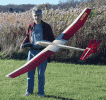|
|
June 1946 Radio-Craft
 [Table of Contents] [Table of Contents]
Wax nostalgic about and learn from the history of early electronics.
See articles from Radio-Craft,
published 1929 - 1953. All copyrights are hereby acknowledged.
|
sink-me
"Radio Pen" 28 Years Old
Dr Lee de Forest Original Inventor
After having published Fips's lurid account of his Radio Pen, which caused him
to be immediately fired, cashiered, dismissed, and forbidden to ever re-enter the
premises, for his dastardly conduct in stealing inventions of others (see article
Radio Pen, April issue), Radio-Craft received a letter from Dr. Lee De Forest, who
writes in part as follows:
"Mr. Hugo Gernsback "Editor, Radio-Craft
"I notice that your April issue illustrates and partly describes the 'Radio Pen.'
I remember distinctly that I made complete drawings and specifications of such a
pen away back, either in the early 20's or possibly as far back as 1917. My recollection
is that one of your magazines made quite a feature of this. At that time, the smallest
available radio tube was the 'peanut,' made by Western Electric.
"If you are sufficiently interested, I suggest that you have one of your men
dig back through those early files to see if that published description can be located.
If so, will you not please reproduce it? You see, I am just as jealous as you are
to be known as an early prophet!"
Sincerely yours,
Lee De Forest
Dr. De Forest's memory is very good.
We located the article in the June 1918 Electrical Experimenter, an early Gernsback
publication.
We reprint here a condensation of the article, and also the illustrations that
went with it. It certainly makes interesting reading.
In defense of Fips; we are certain that he did not remember Dr. De Forest's original
account, because no reference to it was made anywhere in his papers, through which
we looked carefully after his brusque dismissal.
We did, however, find the following: He had made numerous notes on other miniature
radio receivers, to wit:
Pocket Lighter Radio
Tie Stick Pin Radio
Earring Radio (For ladies)
Collar-Button Radio
Cuff-Link Radio
This should give a good idea how his mind works.
Of course, it will probably turn out that neither of the suggestions mentioned
are original with him. We are certain that somewhere, some patentee or an early
inventor will sooner or later claim credit.
All this is as it should be. Most so-called "inventors" these days find that
after they are through with their laborious work they discover that their brain-child
is as old as the hills, and that somebody had preceded them possibly before they
were even born.
Dr. De Forest's article from the June 1918 issue Electrical Experimenter follows:
A "Fountain Pen" Radio Receiving Set
To Dr. Lee De Forest must be given the credit for developing a receiver which
is only slightly larger than an ordinary fountain pen. With it, a secret service
man has but to walk in the vicinity where a "spy radio station" is suspected, with
the chance that he may locate the informer at his instrument.
With this "fountain pen" radio receiver it has been possible to hear stations
eight to ten miles away, with little difficulty and only a small aerial. In the
sectional view shown here it may be seen how it is hooked up. This sensitive receiver
depends entirely upon the Audion for its efficiency, and it is only this extremely
sensitive detector that has made possible a truly practical receiver of this small
type.
It has been found that by using what is known as a: "soft" Audion a fair degree
of sensitiveness is achieved with a battery of only four volts, whereas a standard
Audion requires a potential many times that amount.
The tuning of the set is accomplished by means of a small coil, wound with No.
40 magnet wire. Taps are taken off from the coil and led to a number of points over
which slides a contact mounted on the movable cap at the end of the receiver. By
moving the cap one way or another the wave-length is altered to conform with the
incoming wave. The tuning coil answers satisfactorily for short wave-lengths, and
the Audion is connected directly to it, having an untuned secondary. The battery
is placed in the middle of the receiver and at the end is placed the telephone receiver
consisting of a special magnet, bobbin, diaphragm and ear-piece. The antenna and
ground connections are instantly made by a special double contact plug.
Unlike Mohammed U. Fips' later invention, this early pen required an aerial and
ground.
The older (and much bigger) Radio Pen had a range of 10 miles.
To operate the instrument the person using it has a metal plate attached to the
heel of one shoe, to which is attached the ground wire leading to the set, the wire
being passed through the trouser leg so as not to be seen. The wire to the antenna
is run down through the coat sleeve and into a hollow cane which may contain a spiral
aerial or a similar arrangement.
Standing against an iron fixture which connects with the ground the operator
places the metal electrode on the heel in contact with the same. The cane containing
the antenna is held over the shoulder or in any position not likely to cause attraction.
The earpiece is placed against the ear and the other end adjusted till the signals
are heard loudest.
Posted
|








